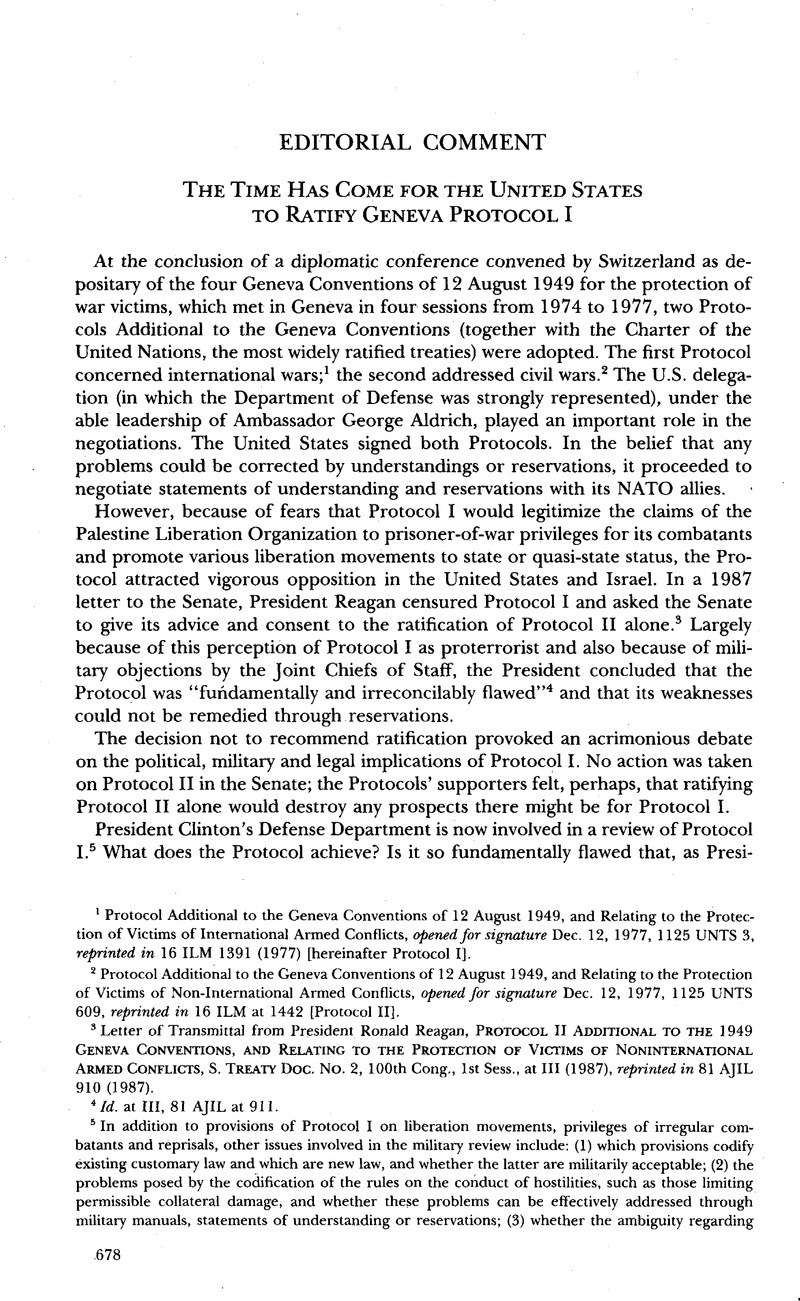Article contents
The Time Has Come for the United States to Ratify Geneva Protocol I
Published online by Cambridge University Press: 27 February 2017
Abstract

- Type
- Editorial Comment
- Information
- Copyright
- Copyright © American Society of International Law 1994
References
1 Protocol Additional to the Geneva Conventions of 12 August 1949, and Relating to the Protection of Victims of International Armed Conflicts, opened for signature Dec. 12, 1977, 1125 UNTS 3, reprinted in 16 ILM 1391 (1977) [hereinafter Protocol I].
2 Protocol Additional to the Geneva Conventions of 12 August 1949, and Relating to the Protection of Victims of Non-International Armed Conflicts, opened for signature Dec. 12, 1977, 1125 UNTS 609, reprinted in 16 ILM at 1442 [Protocol II].
3 Letter of Transmittal from President Ronald Reagan, Protocol II Additional to the 1949 Geneva Conventions, and Relating to the Protection of Victims of Noninternational Armed Conflicts, S. Treaty Doc. No. 2, 100th Cong., 1st Sess., at III (1987), reprinted in 81 AJIL 910 (1987).
4 Id. at III, 81 AJIL at 911.
5 In addition to provisions of Protocol I on liberation movements, privileges of irregular combatants and reprisals, other issues involved in the military review include: (1) which provisions codify existing customary law and which are new law, and whether the latter are militarily acceptable; (2) the problems posed by the codification of the rules on the conduct of hostilities, such as those limiting permissible collateral damage, and whether these problems can be effectively addressed through military manuals, statements of understanding or reservations; (3) whether the ambiguity regarding the application of the Protocol to nuclear warfare (most of the participants in the diplomatic conference had intended to limit it to conventional warfare but did not spell it out in the Protocol’s text) might weaken nuclear deterrence, since military experts believe that it would not be possible to conform the use of nuclear weapons to the provisions on proportionality and collateral damage to civilians; and whether this problem can be remedied by an understanding or a reservation (to be sure, the question of the legality of the use of nuclear weapons arises also under the customary law of war, apart from Protocol I); (4) what in practical terms is involved by the apparently increased obligation for armed forces to care for all sick and wounded regardless of the availability of civilian medical facilities; (5) the practical effect of the new regime on the operation of medical aircraft and the implementation problems in light of modern technology; (6) the practicality and military acceptability of the newly revised annex on identification of medical and religious personnel, involving the use of distinctive protective emblems and signals to facilitate identification of medical aircraft, vessels and facilities; and (7) the seriousness of the ambiguity built into several provisions of the Protocol and the possibility of its leading to contradictory, and sometimes extreme, interpretations.
6 For a discussion of the background of Article 1(4) and explanation of the ineffectiveness of that article, see George H. Aldrich, Prospects for United States Ratification of Additional Protocol I to the 1949 Geneva Conventions, 85 AJIL 1, 4–7 (1991).
7 Theodor Meron, Human Rights and Humanitarian Norms as Customary Law 62–70, 74–78 (1989).
8 For some U.S. views on the Law of the Sea Convention, see Law of the Sea Forum: The 1994 Agreement on Implementation of the Seabed Provisions of the Convention on the Law of the Sea, infra p. 687.
9 U.S. Dep’t of Defense, Conduct of the Persian Gulf War: Final Report to Congress, Pursuant to Title V of the Persian Gulf Conflict Supplemental Authorization and Personnel Benefits Act of 1991, App. O, at 0-13 (1992).
10 Id.
11 U.S. Dep’t of Defense, message (unpublished) (on file with author).
12 Oliver Wendell Holmes, The Common Law 1 (Boston, Little, Brown 1881).
13 Aldrich, supra note 6, at 7, observes:
If it were feasible to apply the Geneva Conventions and Protocol I to the armed conflicts for which that provision [Art. 1(4)] was designed, compliance with these treaties would bring significant humanitarian benefits. Such application and compliance have not been feasible and seem unlikely to become feasible for a multitude of reasons, both political and practical. In effect, the provision is a dead letter.
14 Commentary on the Additional Protocols of 8 June 1977 to the Geneva Conventions of 12 August 1949, at 522–25 (Yves Sandoz, Christophe Swinarski & Bruno Zimmermann eds., 1987).
15 UN Doc. S/PV.3217, at 15 (May 25, 1993).
16 UN Doc. A/CONF.95/15, Apps. A–D (1980), opened for signature Apr. 10, 1981, reprinted in 19 ILM 1524 (1980), and S. Treaty Doc. No. 25, 103d Cong., 2d Sess. (1994). See Contemporary Practice of the United States Relating to International Law, infra p. 748.
17 Letter of Transmittal from President William J. Clinton, S. Treaty Doc. No. 25, supra note 16. President Clinton had previously, on November 23, 1993, submitted the Convention on the Prohibition of the Development, Production, Stockpiling and Use of Chemical Weapons to the Senate for advice and consent to ratification. For that Convention, opened for signature Jan. 13, 1993, see 32 ILM 800 (1993), S. Treaty Doc. No. 21, 103d Cong., 1st Sess. (1993).
18 May 14, 1954, 249 UNTS 240.
19 Letter of Transmittal from President William J. Clinton, supra note 17, at IV.
- 6
- Cited by




